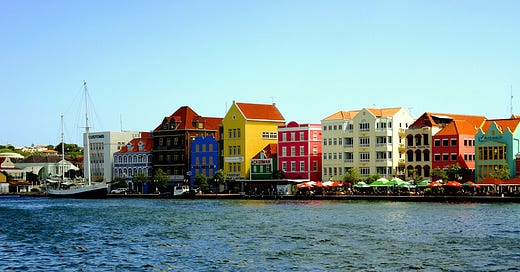Hello there! Welcome to Curaçao, an island with nearly perfect weather every day of the year and some of the best scuba diving in the Caribbean. Come along on my journey of calling this beautiful place home.
Blogging About Curaçao
So I’m Alex for those of you who don’t know me. I’m a freelance writer who, up until this point, has only written for other people. It’s silly really; the last four years have my life could have made for a great blog. Maybe I didn’t think I had anything interesting enough to share? Or perhaps I’ve just been lazy.
Regardless of how we got here, I knew I had to start a blog about Curaçao. I don’t know if any of you out there have ever tried to find decent English-language information about life in Curaçao. I have. It doesn’t exist. Every other place I’ve lived around the world had something useful, but not for Curaçao. At least give me an active Facebook group, for goodness sake!
Curaçao: The Basics
Before we go any further, I figured it would be best to catch you up to speed with some fundamental facts about Curaçao. You know, so we can all be on the same page.
Where is Curaçao
For those of you unfamiliar, Curaçao is a small, semi-autonomous island nation in the southern Caribbean Sea. Located just 40 miles north of Venezuela, Curaçao is part of the ABC islands of the Dutch Caribbean along with Aruba and Bonaire. Approximately 150,000 people call this 171 square mile island home.
The name Curaçao comes from the name for people indigenous to the island. When the Spanish settled the island, they wrote it with a cedilla or little hook on the ‘c’ to designate its pronunciation. From this point forward, I will be skipping the cedilla because it’s a pain to type, and I am officially acknowledging that I know it’s wrong. Sue me.
A Brief History of Curacao
Curacao was colonized for hundreds of years, first by the Spanish, who arrived in 1499, later by the Dutch. Then, in 1634, the Dutch West India Company invaded the island and has kept some level of control over the island ever since. There’s some pretty dark history here, but I will focus on what I’ve observed as still affecting daily life.
In the early 20th century, the economy relied on refining Venezuelan oil. Then during an economic downturn in the 1980s, Royal Dutch Shell decided to end their activities on the island. This led to severe financial hardship and significant immigration to the Netherlands lasting through the early 2000s.
Finally, in 2010, Curacao became a country. Albeit a country within the Kingdom of the Netherlands. There still is some animosity against the Dutch from the local Curaçaoan, a topic I will explore more after I’ve been here longer and understand more. All I’ll say is people seem to like me better when they find out I’m not Dutch.
Daily Life in Curacao
While I’ve only been here six weeks, I noticed a few things right away about life in Curacao. I plan to explore all of these topics further in future blogs, so stay tuned!
Things to Do in Curacao
Hands down, the best things to do in Curacao aren’t on the island itself but around it. There are tons of gorgeous beaches to visit and some of the best snorkeling and scuba diving I’ve ever experienced.
Walking around Punda and Otrabanda (the city centers of Willemstad) is lovely for you land lovers out there. All the buildings are painted fun, bright colors that pop against the blue ocean. I also hear there are great hiking spots on the island’s west side, but I have yet to venture that far.
Infrastructure
I hate to say it, but the infrastructure on the island isn’t great. Mail is slow, there are constant supply chain issues, and it’s challenging to get around without a car. Some of these things are easily chalked up to being a tiny island in the southern Caribbean, while others will hopefully see improvement over the coming years.
Also, most businesses have little to no internet presence. So good luck trying to figure out when the nearest “Toko” is open! One of the main goals of this blog will be to identify the best places to go to find the things you need, something I’m still struggling with. Like, where the heck is the hardware store?
Language
Curacao is a genuinely multilingual society, with two official languages, Papiamento and Dutch. Papiamento is a creole language spoken by locals based on Spanish and Portuguese. However, Curacaoeans almost always speak one or two other languages along with Papiamento.
Meanwhile, Dutch is the primary language for the government and for all the Dutch ex-pats that call the island home. The next most common language is Spanish, followed by English. No wonder there aren’t as many resources available about Curacao in English.
An essential word to know here in Curacao is dushi. It directly translates from Papiamento to tasty in English but means so much more. Dushi can be sweet, nice, or good but also a pet name like “sweetheart.”
So follow along as I Discover Dushi on the beautiful island of Curacao.
My Journey to Curacao
Want to know how I ended up here? Stay tuned for next week’s newsletter, where I get a bit more personal and detail the crazy series of events that led me to move to Curacao!




Great read 📚 your 👏